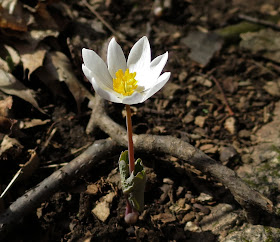Trout Lily (Erythronium americanum). Some Trout Lilies have red anthers and some have yellow. The ones that grow in the Skidmore woods have red, but that Red-necked False Blister Beetle will eat all the pollen away and leave just withered black threads. If you want to see these lovely lilies in their prime, better look for them before the beetles eat their fill.
Bloodroot (Sanguinaria canadensis). Those wrap-around leaves will grow larger, and on rainy days will shelter the closed flower to protect its pollen. Bloodroots have a very brief bloom time, but they bloom profusely, and I often find gorgeous patches of them right along country roads.
Early Blue Cohosh (Caulophyllum giganteum). This species of Blue Cohosh has purple flowers that open and shed pollen even before the leaves have completely unfurled. A second species of Blue Cohosh, Caulophyllum thalictroides, can also be found in the Skidmore woods, but that species will bloom a week to 10 days later, with yellow flowers that wait to open until its leaves have opened too. The two species can be found growing side by side, with no evidence of hybridizing.
Spicebush (Lindera benzoin). Scratch just a bit of the bark to detect its spicy smell. The ripe berries can be dried and powdered to substitute for Allspice.
Wild Ginger (Asarum canadense), just sprouting its fuzzy leaves above its equally fuzzy baby flower bud. Not related to the ginger we buy in little spice jars for our pumpkin pie, or the knobby roots we grate into our Asian cooking. But the thick juicy rhizomes of Asarum canadense do taste quite a bit like that spice, without being nearly so fiery.





Great group of early spring flowers!
ReplyDelete